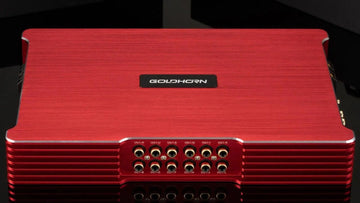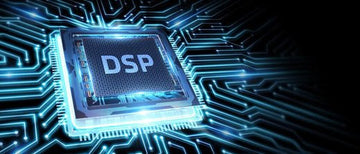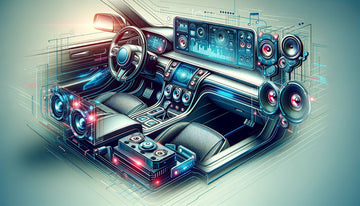A digital signal processor, or DSP, is a type of microprocessor that helps process digital signals. It is an electronic device that does math operations on digital data, like audio, video, and image signals. This helps to change, analyze, and improve these signals. DSPs have special parts and algorithms that allow them to work quickly and accurately while using less power. They are important in many areas, such as telecommunications and audio processing. This blog will explore digital signal processing, its main parts, uses, and benefits.
Understanding Digital Signal Processors
Before we talk about the main parts of a digital signal processor, we should first look at signal processing basics. Signal processing is about analyzing, changing, and creating signals. These signals can be audio, video, images, or any data that carries information. Digital signal processing, or DSP, is when we work with signals in a digital way. This means we represent signals using distinct values.
Basics of Signal Processing
Digital signal processing is key for handling data memory in electronic devices. It makes it easier to multiply signals, which speeds up processing. DSP algorithms are important for handling real-world signals like audio and video. They help process audio samples and video data quickly and effectively.
Analog vs. Digital Signals
Digital signals are shown using specific values. In contrast, analog signals use smooth, continuous values. Digital signal processing, or DSP, gives high precision and accuracy. This makes it great for tasks that need top-quality processing. DSP changes analog signals into digital ones. This change allows processing to happen in electronic devices. The digital form makes it easier to work with audio, video, and images.
A digital signal processor, or DSP, is helpful in audio processing. It can make your sound quality better and take away background noise. You can also add effects like reverb or echo in your stereo system. The DSP looks at digital audio signals and uses math to change the signal right away. This gives you better audio output.
A digital signal processor, or DSP, is a special type of microprocessor. It helps with tasks like filtering, encoding, decoding, and compressing digital signals. You often find it in audio and video processing, telecommunications, and other types of signal processing applications.
What is the purpose of a signal processor?
Signal processors are devices that change electrical signals to modify their features. They are used in many areas like audio signal processing, telecommunications, and image processing. These devices help enhance, filter, or compress signals, making them better and more efficient.
Critical Components of a Digital Signal Processor
Now that we know the basics of digital signal processing, let’s look at the important parts of a digital signal processor. These parts work together. This helps in processing digital signals quickly and efficiently.
Architecture and Design
The design of digital signal processors (DSP) has special parts made for signal processing. DSP focuses on improving math functions and handling audio signals, which makes it very effective for digital signal processing uses. Some helpful features of DSP design allow for fast processing of algorithms. This enables real-time handling of audio, video, and image signals.
Arithmetic Logic Units (ALUs)
Digital signal processors use Arithmetic Logic Units (ALUs) to handle math tasks on digital signals. This includes several matrix operations. The ALUs are made to perform mathematical functions effectively in digital signal processing. This helps achieve high precision and accuracy. The better precision of ALUs allows for faster signal processing. This means audio, video, and images can be processed in real-time. ALUs can perform tasks like multiplication and Fourier transforms, which are essential for signal processing.
Memory Units
Memory speed and type are very important for how well digital signal processing (DSP) works. DSP memory units help with direct memory access, which improves how signals are processed. Quick access to data memory is key for working with audio, video, and image data. This access lets processors get signals fast when they are working. Digital signal processors rely on data memory to store and access digital signals. This helps them process real-time signals quickly. Accessing program memory well is also important for making signal-processing algorithms work better.
Applications of Digital Signal Processors
Digital signal processors are used in many areas. This is because they are fast, accurate, and use power efficiently. Let’s look at some important uses of digital signal processors.
Audio and Video Processing
DSP algorithms are very important for processing audio. They help improve sound quality, bass response, and overall listening experience. Digital signal processors, or DSPs, are also used for video processing. They focus on optimizing video data and enhancing video quality. By processing audio signals, DSPs maintain signal integrity and quality. This leads to high-quality audio processing. Overall, DSP algorithms are key for better audio and video experiences for users.
Telecommunications
Digital signal processors play an important role in handling signals for fast data transfer in telecommunications systems. DSP algorithms help make signals clearer by lowering noise and boosting signal quality in these applications. In mobile phones, digital signal processors assist with audio signal processing, improving sound quality, and managing the user interface. Also, the power efficiency of digital signal processors means they use less energy, which helps extend the battery life in mobile devices.
Medical Imaging
In medical imaging, digital signal processors (DSP) are used to process medical images in real-time. This allows doctors to make quick diagnoses. DSP algorithms help improve image quality and analyze the data accurately. They use math functions like the Fourier transform to improve processing speed and accuracy. Digital signal processing (DSP) is very important in medical devices for handling signals effectively.
Automotive Systems

Digital signal processors, or DSPs, are commonly used in cars, especially for audio processing. They help make the sound better by improving sound quality and bass. DSP algorithms enhance the audio in vehicles, giving passengers a richer listening experience. These processors carry out real math operations for car audio processing, which leads to high-quality sound. Moreover, digital signal processors are important in sensors for processing analog signals. This allows for many uses, from video processing to how users interact with the car.
Integration with Modern Technologies
Digital signal processors, or DSPs, are fitting into modern technology more and more. This is making them even better and more useful. DSPs work closely with AD/DA converters. These converters help change analog signals into digital signals and back again. This change helps data flow smoothly in many systems.
AD/DA converters are key parts in audio and video work. They help to create great sound quality and manage data well in new devices. Also, synchronizers help DSPs work nicely with other parts. This reduces delays and boosts how well the whole system works.
As technology grows, combining DSPs with advanced parts continues to spark new ideas. This affects many areas, including telecommunications and automotive systems.
AD/DA Converters
AD/DA converters are important tools in digital signal processing. They connect the analog world with the digital world. These converters help digital signal processors change analog signals, like sound waves, into digital data that can be processed. This change is essential for things like recording and playing audio, where clear sound and precision are very important.
On the other hand, DA converters take the processed digital signals and turn them back into analog signals. This allows sound to be played through speakers or other analog devices. DSPs use AD/DA converters to improve signal quality. This way, the quality of the audio or video stays high during the conversion process.
In short, AD/DA converters are key to getting great results in audio and video signal processing.
The efficiency of AD/DA converters greatly affects how well digital signal processors work. Good quality converters reduce distortion and noise during conversion. This is very important for professional audio work. In music production, broadcasting, and live sound, passive AD/DA converters play a key role. They keep signals close to their original quality. This allows DSPs to perform their best and deliver great results.
AD/DA converters improve audio quality and are used in many signal processing situations. This includes telecommunications, compressor systems, and data collection systems. They help create accurate signal representations. This allows digital signal processors to manage and work with different types of data effectively.
Synchronizers
Synchronizers are very important parts of digital signal processing systems. They help make sure that all digital components work together in harmony. In digital signal processing, synchronizers provide exact clock signals, which are needed for timing. This synchronization is key for keeping the processed signals accurate. This is especially important in cases with several channels or components. By keeping everything in line, synchronizers help stop delays and jitter. These issues can lower the quality of the signal significantly.
Synchronizers are very important in complex signal processing tasks like audio and video production. In these cases, DSPs need to handle several signals at the same time without losing sync. Synchronizers help make sure that all input signals are timed correctly. This enables DSPs to run algorithms well and create high-quality outputs. This level of accuracy is crucial in professional audio settings. Even small mistakes can cause noticeable issues in sound quality.
The addition of synchronizers to digital signal processors (DSPs) improves how the system works. They help different parts communicate better. This allows DSPs to handle data flow effectively, making sure tasks run without issues. As technology grows, the need for strong synchronizers is also increasing. This shows how important they are in today’s digital signal processing applications.
Advantages of Using Digital Signal Processors
Digital signal processors have several benefits. This is why they are a popular option for signal processing tasks. Here are some key advantages of using digital signal processors.
How does a DSP differ from a CPU?
Digital signal processors (DSPs) are different from general-purpose CPUs. They are made for math tasks on analog signals. DSPs have special instructions that make it easier to handle signal processing quickly. They use direct memory access to read and write data efficiently, while regular microprocessors can't do this as well. Their design and algorithms also work better for data memory, audio signals, image processing, and math operations.
Exploring the DSP Market and Future Trends
The DSP market is growing quickly. This growth is due to the rising need for high-quality digital processing in many areas. As industries change, the requirement for good and efficient signal processing solutions grows stronger. Digital signal processors lead this change, providing the advanced features needed for today’s audio, video, and data uses.
Future trends show that the DSP market will keep growing. New ideas in processing and algorithms are making DSP solutions stronger and more flexible. Companies are putting money into research and development to boost the skills of digital signal processors. They aim to make processing faster, use less power, and work better with new technologies. Because of this, we will likely see DSPs being more important in areas like artificial intelligence, the Internet of Things (IoT), and smart technologies. In these fields, processing data in real-time is key for good performance and function.
Signal Processing Accessories
Signal processing accessories, like mic preamps, are important tools that improve how digital signal processors work. These accessories help in many areas, such as audio and video processing, as well as telecommunications. Here are some key accessories that are really important in signal processing:
- Rackmount Kits: These kits help to mount DSPs and other processing units securely. They keep everything organized in professional places, making it easy to access and allowing good airflow.
- Stereo Adapters: Stereo adapters help connect different audio devices. They allow DSPs to work well with current audio equipment.
- Remote Controls: Remote controls allow users to operate DSPs from far away. This offers convenience during live shows or studio work.
- Cables and Connectors: Good quality cables and connectors are important. They help keep audio and video signals clear and free from distortion.
By using these accessories, users can get the most out of their digital signal processors. This will help them perform better in different tasks. As more people look for better signal processing solutions, these accessories will become even more important. They are key items in the field of digital signal processing and its lexicon.
Frequently Asked Questions
How does a digital signal processor differ from a microcontroller or microprocessor?
Microcontrollers and microprocessors are general-purpose devices. However, digital signal processors (DSPs) are made to work with digital signals like audio or video. Microcontrollers are tiny computers housed in single chips that help control other devices. Microprocessors serve as central processing units (CPUs) that can run any program. DSPs are different because they have special hardware, specific instructions, and methods to perform quick and efficient signal processing tasks.
Enhancing Audio Quality with DSPs
Digital signal processors (DSPs) are very important for making audio sound better in many areas. They use smart methods to change and improve the sound. A major strength of DSPs is in audio equalization and signal processing. They look at sound waves and change them to create the effects people want.
DSPs can do jobs like equalization, compression, and noise reduction. These tasks help create great audio outputs, especially in loudspeaker systems. For example, an equalizer can change how audio signals respond to different frequencies. This lets users adjust the sound to their liking. This sort of customization is very important in professional audio production. Getting the perfect sound is key in that field.
DSPs are commonly used in audio devices like headphones and speakers. They improve how we listen to music and sounds. With DSP technology, makers can offer features such as virtual surround sound and personalized sound settings. This helps users get the best audio quality in any place. As more people want better audio experiences, DSPs will stay important for how we feel and enjoy sound.
https://www.youtube.com/embed/82pYzfP7Plc?showinfo=0
When you think about buying a digital signal processor (DSP), it is important to know what factors affect its performance and how it fits specific needs. Here are some key points to think about in your buying guide:
- Processing Power: Check the power of the DSP. This affects how well it can manage tricky audio and video tasks, like Bluetooth audio streaming. Look for DSPs with fast clock speeds and a strong build for the best results.
- Connectivity Options: Make sure the DSP has several connection choices. It should include both digital and analog inputs and outputs. This helps you connect it easily to your current audio or video devices.
- User Interface: A simple user interface is very important. It helps you change settings and use features easily. Look for DSPs with easy controls, clear screens, and software support to make things simpler for you.
- Versatility: Find DSPs that can do many jobs, from audio processing to video improvement. A versatile DSP means you can still use it as your needs change over time.
When you think about these factors, you can choose a good digital signal processor. This will help you make sure it fits your needs. It should give great performance for your audio or video work.
Fine Tuning Your Car’s Stereo Sound
Fine-tuning your car's stereo can really improve how you enjoy music. Digital signal processors (DSPs) and equalizers are very important for this. With DSP technology and an equalizer, you can change audio settings to get just the right sound in your car. Here are some key tips to help you make your car's audio system even better:
- Use Equalization (EQ): DSPs let you change how different sounds come through your audio system. This helps you boost bass, mids, and treble. Try different EQ settings to find your favorite sound.
- Adjust Time Alignment: Getting the timing right is important for a good sound. DSPs can help you make sure the audio from all your speakers reaches you at the same time. This makes the listening experience feel more real.
- Add Crossover Settings: With DSPs, you can set crossover frequencies. This means you can send the right sounds to the right speakers. It makes sure your subwoofers, woofers, and tweeters work their best and sound clear without any distortion.
You can improve your car's stereo sound by using digital signal processors through a USB connection. This will change your driving time into a great audio experience. It does not matter if you listen to music for fun or if you are very serious about sound quality. A properly set up audio system can really enhance the way you enjoy your favorite songs while driving.
Conclusion
In conclusion, a digital signal processor (DSP) is a strong tool for signal processing. It is often used in different areas such as telecommunications, audio, video processing, medical imaging, and automotive systems. The design of a DSP, which includes its arithmetic logic units (ALUs), memory units, and input/output interfaces, helps it work well with tough math tasks. Unlike regular CPUs or microcontrollers, DSPs are made to process data in real-time. They can carry out tasks quickly and accurately.
The benefits of using DSPs are clear. They can quickly process big data. They are also flexible with different signals and save money. As more fields need better signal processing, DSPs help create new technologies and enhance system performance.
In conclusion, learning the basics of DSPs is important. Knowing what they are, how they are used, and their benefits can help you see why these processors are so important in the digital world today.




